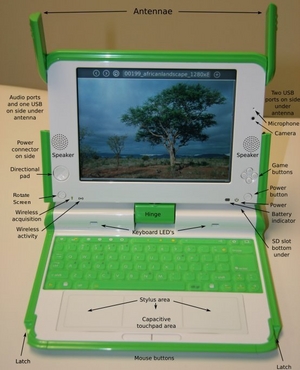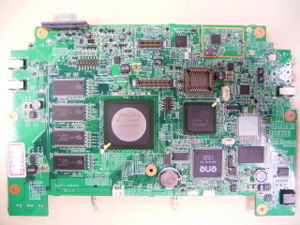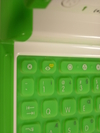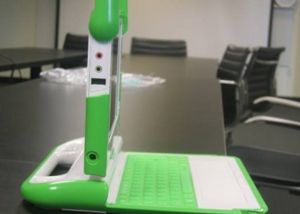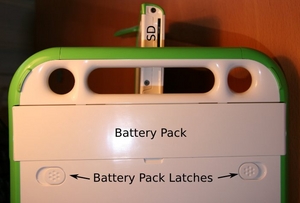Hardware specification
| deutsch | english | español | français | italian | 日本語 | 한글 | português | русский indonesia | HowTo [ID# 28738] +/- |
See also Hardware
Remove this section once the sidebar points to Hardware rather than here.
Hardware details for OLPC, November 30, 2006
Maintained from a document written by Michael Bove by Jim Gettys.
Future Beta Test Systems
Several more builds of beta systems are planned for 2007.
Beta Test 2 Systems (BTest-2)
Approximately 2500 systems were built by Quanta and are being distributed. These are fully functional machines with CaFE asic's, and reflect some, but not all of the learning and improvements from testing of BTest-1. Much more information about the BTest-2 systems can be found in the BTest-2 Release Notes. Some of the details of the hardware design are to support the OLPC Human Interface Guidelines.
BTest-2 systems are almost identical visually with BTest-1. BTest-3 will have more substantial physical differences. An easy way to tell the difference between BTest-1 and BTest-2 is that BTest-1 keyboards have white lettering, and BTest-2 has black lettering.
Beta Test 1 Systems (BTest-1)
Approximately 875 systems were built by Quanta and were distributed. These are fully functional machines, but built before the rigorous testing that will now take place. Much more information about the BTest-1 systems can be found in the BTest-1 Release Notes.
Specifications
Physical dimensions:
- Dimensions: 242mm × 228mm × 30mm (approximate, subject to change)
- Weight: Less than 1.5 KG (target only—subject to change)
- Configuration: Convertible laptop with pivoting, reversible display; dirt- and moisture-resistant system enclosure
Core electronics:
- CPU: AMD Geode LX-700@0.8W
- CPU clock speed: 433 Mhz
- Compatibility: Athlon instruction set (including MMX and 3DNow! Enhanced) with additional Geode-specific instructions
- Chipset: AMD CS5536 South Bridge (datasheet)
- Graphics controller: Integrated with Geode CPU; unified memory architecture
- Embedded controller (for production), ENE KB3700: File:KB3700-ds-01.pdf
- DRAM memory: 256 MiB dynamic RAM
- Data rate: Dual – DDR266 – 133 Mhz
- BIOS: 1024KB SPI-interface flash ROM; LinuxBIOS open-source BIOS; Open Firmware bootloader
- Mass storage: 1024 MiB SLC NAND flash, high speed flash controller
- Drives: No rotating media
Display:
- Liquid-crystal display: 7.5” Dual-mode TFT display
- Viewing area: 152.4 mm × 114.3 mm
- Resolution: 1200 (H) × 900 (V) resolution (200 dpi)
- Mono display: High-resolution, reflective monochrome mode
- Color display: 800 (H) x 600 (V) or greater transmissive color mode
- Power Consumtion: 0.1 Watt with backlight off; 0.2-1.0 Watt with backlight on
- Timing Controller Chip with memory that enables the display to remain live with the processor suspended. This display and chip are the basis of our extremely low power architecture. The machine can be running with the CPU and much of the motherboard turned off. The timing controller chip also enables deswizzling and anti-aliasing in color mode. You can examine this photograph of the display (it looks even nicer in person; photographing a display is remarkably difficult).
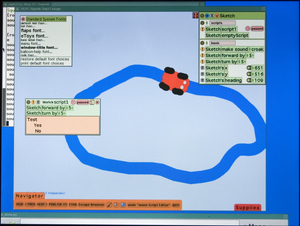
Integrated peripherals:
- Keyboard: 70+ keys, 1.2mm stroke; sealed rubber-membrane key-switch assembly
- Keyboard Layouts
- Layout pictures - US International, Thai, Arabic, Spanish, Portuguese, Nigeria
- Cursor-control keys: five-key cursor-control pad; four directional keys plus Enter
- Touchpad: Dual capacitance/resistive touchpad; supports written-input mode
- Audio: Analog Devices AD1888, AC97-compatible audio codec; stereo, with dual internal speakers; monophonic, with internal microphone and using the Analog Devices SSM2211 for audio amplification
- Wireless: Marvell Libertas 88W8388+88W8015, 802.11b/g compatible; dual adjustable, rotating coaxial antennas; supports diversity reception
- Status indicators: Power, battery, WiFi; visible lid open or closed
- Video camera: 640x480 resolution, 30FPS
External connectors:
- Power: 2-pin DC-input, 10 to 25 V, -23 to -10 V
- Line output: Standard 3.5mm 3-pin switched stereo audio jack
- Microphone: Standard 3.5mm 2-pin switched mono microphone jack; selectable sensor-input mode
- Expansion: 3 Type-A USB-2.0 connectors; SD Card slot
- Maximum power: 500 mA (total)
Battery:
- Pack type: 5 Cells, 6V series configuration
- Fully-enclosed “hard” case; user removable
- Capacity: 22.8 Watt-hours
- Cell type: NiMH
- Pack protection: Integrated pack-type identification
- Integrated thermal sensor
- Integrated polyfuse current limiter
- Cycle life: Minimum 2,000 charge/discharge cycles (to 50% capacity of new, IIRC).
- Power Management will be critical
BIOS/loader:
- LinuxBIOS is our BIOS for production units; Open Firmware is used as the bootloader.
Environmental specifications:
- Temperature: somewhere in between typical laptop requirements and Mil spec; exact values have not been settled
- Humidity: Similar attitude to temperature. When closed, the unit should seal well enough that children walking to and from school need not fear rainstorms or dust.
- Altitude: -15m to 3048m (14.7 to 10.1 psia) (operating), -15m to 12192m (14.7 to 4.4 psia) (non-operating
- Shock: 125g, 2ms, half-sine (operating) 200g, 2ms, half-sine (non-operating)
- Random vibration: 0.75g zero-to-peak, 10Hz to 500Hz, 0.25 oct/min sweep rate (operating); 1.5g zero-to-peak, 10Hz to 500Hz, 0.5 oct/min sweep rate (nonoperating)
- 2mm plastic walls (1.3mm is typical for most systems).
Regulatory requirements:
- The usual US and EU EMI/EMC requirements will be met.
- The laptop and all OLPC-supplied accessories will be fully UL and is RoHS compliant.
Pre-BTest boards
A small number of pre-BTest boards were built in preparation for building complete BTest systems. Developer information about B-test boards are here.
Alpha Test Prototype Electronics
Power up of the first OLPC electronics prototype boards occurred April 15, 2006. Power and ground testing continued over the weekend, and formal debug and BIOS bring up started Monday, April 17, 2006 at Quanta Computer's labs in Taipei, Taiwan. By Wednesday, April 19, Linux was booting on the first generation prototypes.
Photographs:
- Component side OLPC circuit board
- Back side of the OLPC circuit board
- Picture of Linux running with circuit board in the lab
- Picture of the screen of Linux running on the OLPC circuit board; fittingly, it shows a Chinese desktop
See also
Formerly part of this page:
